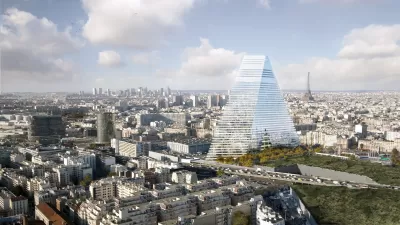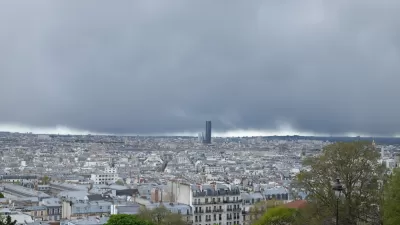Paris’ reinstated height limits, lowering height limits allowed in 2010, are part of Mayor Anne Hidalgo’s recently released Bioclimatic Local Urban Plan.

Paris has reimposed a height limit for new buildings in the city of height of 37 meters, more 12 stories, according to an article in a French language publication 20 Minutes.
The height limit redux “reinstates the same Parisian planning law that was introduced in 1977 following the construction of Tour Montparnasse, a 210-metre-tall office tower by architects Eugène Beaudouin, Urbain Cassan and Louis Hoym de Marien that was also highly contested,” according to an article by Lizzie Crook for Dezeen.
In 2010, former Paris Mayor Bertrand Delanoë raised the height limit to 180 meters for office buildings and 50 meters for housing developments.
This time, the height limit responds to “the controversial construction of Tour Triangle tower designed by Swiss studio Herzog & de Meuron,” according to Crook, who adds that the reinstated height limit is considered a component of current Mayor Anne Hidalgo’s Local Bioclimatic Urban Plan, unveiled earlier in June, which is aimed at reducing Paris’ carbon emissions.
According to an article on Sortir Paris, the Bioclamatic Urban Plan has three primary focuses, including development limitations that install an urban growth boundary and ambitious goals for social housing:
- “Limiting new construction: No new building may exceed 37 meters in height. The area around the ring road will be protected, with no construction allowed within a 25-metre zone around it, barring specific exceptions.
- “More green space: The plan calls for the development of 300 hectares of additional green space by 2040. At the same time, the city is committed to planting 170,000 trees by 2026.”
- “Increase in social housing: The aim is to achieve 30% social housing by 2035. In certain zones, new projects over 500m2 will have to include at least 50% social housing.”
FULL STORY: Paris reinstates skyscraper ban following Tour Triangle backlash

Trump Administration Could Effectively End Housing Voucher Program
Federal officials are eyeing major cuts to the Section 8 program that helps millions of low-income households pay rent.

Planetizen Federal Action Tracker
A weekly monitor of how Trump’s orders and actions are impacting planners and planning in America.

Ken Jennings Launches Transit Web Series
The Jeopardy champ wants you to ride public transit.

Rebuilding Smarter: How LA County Is Guiding Fire-Ravaged Communities Toward Resilience
Los Angeles County is leading a coordinated effort to help fire-impacted communities rebuild with resilience by providing recovery resources, promoting fire-wise design, and aligning reconstruction with broader sustainability and climate goals.

When Borders Blur: Regional Collaboration in Action
As regional challenges outgrow city boundaries, “When Borders Blur” explores how cross-jurisdictional collaboration can drive smarter, more resilient urban planning, sharing real-world lessons from thriving partnerships across North America.

Philadelphia Is Expanding its Network of Roundabouts
Roundabouts are widely shown to decrease traffic speed, reduce congestion, and improve efficiency.
Urban Design for Planners 1: Software Tools
This six-course series explores essential urban design concepts using open source software and equips planners with the tools they need to participate fully in the urban design process.
Planning for Universal Design
Learn the tools for implementing Universal Design in planning regulations.
Ada County Highway District
Clanton & Associates, Inc.
Jessamine County Fiscal Court
Institute for Housing and Urban Development Studies (IHS)
City of Grandview
Harvard GSD Executive Education
Toledo-Lucas County Plan Commissions
Salt Lake City
NYU Wagner Graduate School of Public Service



























